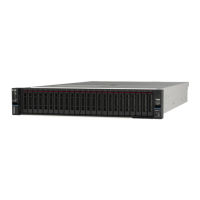Procedure
Step 1. Touch the static-protective package that contains the new part to any unpainted surface on the
outside of the server. Then, take the new part out of the package and place it on a static-protective
surface.
Step 2. Install the firmware and RoT security module to the server.
Figure 100. Installing the firmware and RoT security module
a. Lower the firmware and RoT security module onto the system I/O board and ensure that the
connector on the module is correctly inserted into the slot on the system I/O board.
b.
Tighten the two screws to secure the firmware and RoT security module in place.
After you finish
1. Install any components that you have removed:
•
“Install a riser assembly” on page 93
2. Complete the parts replacement. See “Complete the parts replacement” on page 151.
3. Update the UEFI, XCC and LXPM firmware to the specific version supported by the server. See
Tip for
replacing a firmware and RoT security module
.
4. Perform OneCLI commands to restore the UEFI settings. See
OneCLI commands that restore
configuration settings
.
5. Perform both OneCLI commands and XCC actions to restore the XCC settings. See
OneCLI commands
that restore configuration settings
and Using XCC to restore the BMC configuration.
6. If there is a software (SW) key, for example, XCC FoD key, installed in the system, inject the key again to
ensure that the key functions properly. See
Using Lenovo Features on Demand.
Note: If you need to replace the processor board together with the firmware and RoT security module,
update the VPD before injecting the key. See
Update the Vital Product Data (VPD).
7. Optionally, do the following if needed:
• Hide TPM. See
“Hide TPM” on page 132.
• Update the TPM firmware. See
“Update the TPM firmware” on page 132.
Chapter 5. Hardware replacement procedures 131

